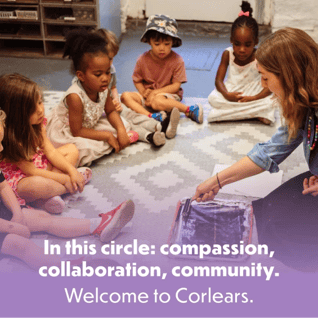Through play and exploration, toddlers in the Roots program take on new environments and experiences with increased comfort and courage while building skills in key developmental areas.
Corlears School supports and celebrates toddlers 12–24 months in developing independence, autonomy, joy, play, and wonderment as they engage in learning experiences that are thoughtfully designed to support overall growth, learning, and achievement.
New York State's Early Learning Guidelines, which feature contributions by Colleen Goddard, Ph.D., Corlears School's Early Childhood Division Director, outline five key developmental domains: 1. Approaches to learning (how children acquire knowledge); 2. Physical development (including gross motor skills); 3. Social and emotional development (forming trusting relationships, sense of self, and more); 4. Language, communication, and literacy; and 5. Cognitive development.
Below, you'll find examples of this learning in action.
Creativity, Inventiveness, and Curiosity

Because Toddler students are at the early stages of their language development, the way they use and interpret the open-ended play materials available in the classroom is the way they communicate about themselves and the world around them. In this example, you can see the children using their hands and tools to learn about play dough. They may be asking themselves as they explore, What does it feel like on my hand and fingers? What does this do? How can I flatten this? How flat can I make it? How can I make this round? Will the ball bounce? How many pieces can I rip from this large piece of dough? As teachers observe these interactions with the play dough, they support the learning by providing students with the words to connect and label their actions.
By practicing their hand-eye coordination and using their muscles to manipulate the dough with their hands, the children are also practicing their fine motor skills. Social and emotional skills development may also come into play if, for example, a student wants a tool that someone else has, and they must practice turn-taking. Cognitive development is also promoted as the children are playing and pretending to make various objects.Gross Motor Learning

In the Toddler classroom, children learn about their bodies in space (also known as spatial awareness), have opportunities to develop their large body muscles and gain confidence and autonomy over their physicality as they navigate through the classroom and are exposed to larger play structures that invite them to crawl, climb, slide, stand, and sit. In the example here with the rocker board, the student is learning how to set “appropriate boundaries for their [body] …. to do things on their own, freely explore autonomous movement and feel respect in their need for independence" (Benson McMullen, M. & Brody, D. [2021]. Infants and Toddlers at Play).
As students navigate the rocker board, foam climber, and other structures, they are learning to balance and shift their weight, which requires motor planning, a mind-body connection, and the strength and confidence to use the climber. Repeated exposure to the same experience promotes an increase of stability and fluidity of their movement over time. Children are “drawn toward opportunities that call for problem solving with different areas of their bodies. Children modify their body positions, relocate their centers of gravity and create a sturdy support system with legs and planted feet” (Benson McMullen, M. & Brody, D. [2021]. Infants and Toddlers at Play).
Rhythms, Routines, and Sense of Self

In the Toddler classroom, social and emotional development (SEL) is the cornerstone of our curriculum. The children are building skills of autonomy, self-advocacy, and awareness of self and others that encourage the transfer of trust from their primary caregivers onto the overall classroom community.
An example of social and emotional learning happens in the dramatic play area, where the children engage in play schemas and playworlds that mirror their lived experiences through play. They cook in the play kitchen, sit at the table for a meal, pretend to eat, care for babies, sweep the floor, open and close doors, and use objects to represent their lifeworld and familial cultures which they bring into the classroom as they create meaningful home-school connections.
Listening, Understanding, and Phonological Awareness

Much of language and literacy for this age group happens by listening and observing, and through repeated exposure to text, song, and patterns. Here, Corlears School's librarian is pictured performing a spirited read-aloud on the floor, at the children's level. In the Toddler classroom, teachers spend a lot of time on the floor! Language development is supported when toddlers are able to see their teachers' faces and mouths move, and how to create the shapes that produce the specific sounds needed for speech; being on their level also helps the children feel valued, acknowledged, and seen.
Moments of language and literacy learning happen all day throughout the Toddler classroom, including during snack time, when they have another opportunity to hear a book read aloud. One of the most important ways that educators can support children’s language development is to read to them; the book read during snack time is usually made available for the children to browse on their own after snack time. Hearing teachers read eventually leads to the child's significant and profound understanding that text, symbols, and sounds have meaning. Teachers also encourage the children to notice one another at the snack table and engage them in conversation in this way. Children are asked to communicate verbally when they want more snacks or need help with their water bottle or chair, which sets the expectation that when they use their words, their trusted grown-ups can understand and respond to their needs.
Spatial Sense, Investigating, and Exploring

Cognitive learning for Toddler students is subtle and less concrete than with older children. In this example at the light table, you can see the children taking risks, trying new ideas, learning through trial and error, and exploring novice materials. When students return to the materials, their prior knowledge and burgeoning understanding of cause and effect supports them in creating new understandings of the world. The children are discovering how the pieces balance, relate to one another, and how they can build upon each other. The magnetic tiles offer a variety of designs and dimensions, which introduces and reinforces shape and color awareness. The transparent nature of the tile invites the children to look through the shapes and experience the room through the specific lens of color, inviting a world of creativity.
These are early scientific and mathematical learnings for children as they explore, discover, relate, and remember. A few other skills the children are developing with this experience include gross motor strength (pulling apart the tiles — some are very strong!) and fine motor skills as they manipulate, maneuver, construct, and even deconstruct. Teachers identify and name the colors, shapes, and structures, which encourages language and early literacy development.
You can learn even more about our curriculum for children ages 12–24 months on our Toddler program page.



